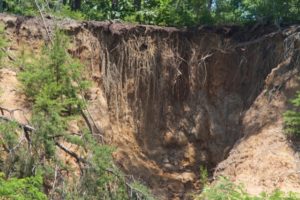STATEMENT:Chesapeake Conservancy: Northam Administration Recognizes Seriousness of Fones Cliffs Violations
Annapolis, MD – Chesapeake Conservancy President and CEO Joel Dunn issued this statement following the decision of the Virginia’s Attorney General’s Office to take under its consideration an enforcement action against the Virginia True Corporation for violations at Fones Cliffs, a significant environmental and cultural feature along the Rappahannock River. Initial violations were documented and issued by the Virginia Department of Environmental Quality (DEQ). A proposed consent order issued by DEQ generated considerable public interest, including strong statements by the Chesapeake Conservancy and partners across the Chesapeake landscape.

Cliff failure after reckless and illegal actions by the developer at Fones Cliffs.
In October 2017, developers began illegally clearing trees and other vegetation, which ultimately totaled 13 acres before the violations were discovered. These scars remain on the land and attempts to control erosion and sedimentation into the Rappahannock River and wetland ravines have repeatedly failed.
“We want to thank our many supporters who signed our petition and wrote letters in support of Fones Cliffs. We are also grateful to the Northam Administration for recognizing the uniqueness of Fones Cliffs and giving these violations the attention they deserve.
“Chesapeake Conservancy will continue to speak out about what we feel is an injustice to current and future generations. The developer’s reckless and illegal actions have significant impacts on the bald eagle population, the preservation of American Indian artifacts likely to exist at the site, and the water quality of the Rappahannock River and Chesapeake Bay. We continue to seek the permanent protection of this special place, which is a nationally significant natural and cultural wonder.”
###
Background: Fones Cliffs is a 4-mile formation along the tidal-fresh portion of the Rappahannock River in Richmond County, Virginia. It is located within the boundary of the Rappahannock River Valley National Wildlife Refuge and is a critical site along the Captain John Smith Chesapeake National Historic Trail. The forested cliffs reach heights of 80 to 100 feet above the river and are composed of diatomaceous earth formed millions of years ago.
This special stretch of the river has one of the highest densities of bald eagles on the east coast. It is home to 100+ pairs of resident breeding bald eagles, which are joined by thousands more throughout the year, as they track waterfowl and fish migrations in the fall and spring. The highest eagle counts ever recorded along the river were made in February 2005, when nearly 400 birds were seen in a single day, with dozens seen in the Fones Cliff stretch of the river. There are many other species of concern that depend upon this habitat, the bald eagle is just the most charismatic, making this a special place within the acquisition boundary of the Rappahannock River Valley National Wildlife Refuge.
Fones Cliffs is among the earliest areas described by New World explorers. Captain John Smith sailed by Fones Cliffs on August 18, 1608. Smith and his crew documented a historic skirmish they had with the Rappahannock Indians that day. Indeed, there is documented evidence of thousands of years of occupation by the American Indians in this location. Standing on the bluffs at Fones Cliffs today, the view is incredibly similar to what it was 400 years ago, making it a vital component of the Captain John Smith Chesapeake National Historic Trail, managed by the National Park Service.
Chesapeake Conservancy’s mission is to strengthen the connection between people and the watershed; conserve the landscapes and special places that sustain the Chesapeake’s unique natural and cultural resources; and restore landscapes, rivers, and habitats in the Chesapeake Bay region. We empower the conservation community with access to the latest data and technology. As principal partner for the National Park Service on the Chesapeake Bay Gateways Network and the Captain John Smith Chesapeake National Historic Trail, we helped create 153 new public access sites and permanently protect some of the Bay’s special places like Werowocomoco, Blackwater National Wildlife Refuge, Harriet Tubman Underground Railroad National Historical Park, and Fort Monroe National Monument. www.chesapeakeconservancy.org